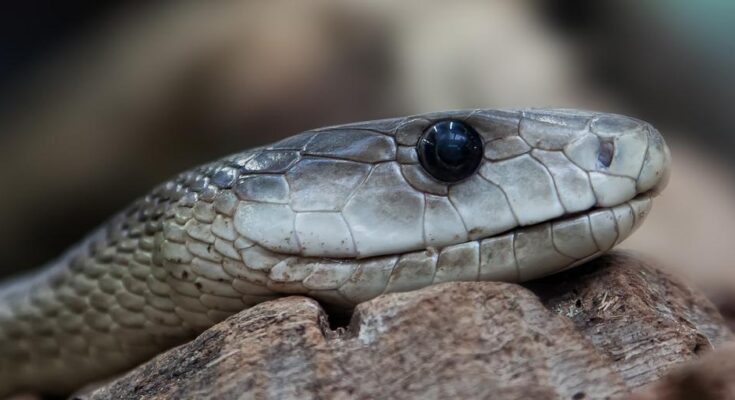Have you ever imagined coming face-to-face with the biggest snakes ever recorded? Picture a creature so massive it could swallow a deer whole, or perhaps stretch out longer than a school bus. Imagine coming across these titans of the natural world in real life – not just on a Hollywood screen!
In this thrilling journey, we’ll explore colossal constrictors like reticulated pythons and boa constrictors that can reach staggering lengths. You’ll learn about venomous giants such as king cobras and black mambas – some of which rank among the longest in their deadly league.
Let’s explore how invasive species, such as Burmese Pythons, affect environments from Southeast Asia to Southwest Florida. And lastly, discover why green anacondas are crowned the heaviest snakes on Earth! Are you set to encounter these slithering marvels?
Table of Contents:
- Unveiling the Giants: The Biggest Snakes Ever Recorded
- Deadly and Enormous: The World’s Most Venomous Snakes
- Python Powerhouses – Reticulated and Burmese Pythons
- Green Anaconda – The Heaviest Snake on Earth
- Boa Constrictor – A Non-Venomous Giant
- The Burmese Python Invasion – An Invasive Species Story
- Record-Breaking Snakes – The Longest and Heaviest
- Snakes in Unexpected Places – Unusual Encounters
- Natural Habitats and Predators of Large Snakes
- Protecting the Giants – Conservation Efforts for Large Snakes
- FAQs in Relation to Biggest Snakes Ever Recorded
- Conclusion
Unveiling the Giants: The Biggest Snakes Ever Recorded
Think of the biggest snake you can imagine. Now, multiply that image by ten and you might just get close to visualizing some of the largest snakes ever recorded.
The Reticulated Python, for example, is one such giant. With a record length reaching up to 32 feet and 9½ inches long, it’s not just big – it’s gargantuan.
Moving from land into water brings us face-to-face with another behemoth: the Green Anaconda. These massive serpents tip scales at an astonishing weight –up to 550 pounds. Their sheer size alone earns them their title as ‘heaviest snake on Earth’.
The King Cobra – A Venomous Giant
We must also give due respect to venomous giants like King Cobras. Not only are they among the longest venomous snakes in existence but their deadly bite adds an extra level of danger.
Python Powerhouses – Reticulated and Burmese Pythons
Rounding out our list are two more titans from the python family; namely, Burmese Pythons. They have been known to reach up to 23 feet in length while weighing around a hefty 200 pounds.
Invasive Species Story – The Burmese Python Invasion
A discussion about these reptilian heavyweights wouldn’t be complete without mentioning the impact of invasive species like Burmese Pythons in Southeast Asia and Southwest Florida. These giants, while impressive, can cause significant habitat destruction.
Whether it’s venomous cobras or weighty anacondas, each of these snakes is a testament to nature’s power and diversity.
Deadly and Enormous: The World’s Most Venomous Snakes
Some snakes stand out for their deadly venom, others for their impressive size. But few combine these traits like the King Cobra and Black Mamba.
The King Cobra – A Venomous Giant
Few creatures command respect like the King Cobra (Ophiophagus hannah). This longest venomous snake is a sight to behold, reaching lengths up to 18 feet. Their powerful neurotoxic venom can take down an elephant.
This formidable serpent holds a unique place in various Asian cultures. They’re both feared as killers and revered as symbols of power and fertility.
Speed and Venom – The Black Mamba
The other titan of our list is none other than the infamous Black Mamba (Dendroaspis polylepis). These agile predators are considered one of Africa’s deadliest snakes due to their potent venom combined with blistering speed.
Black mambas often strike multiple times during an attack, delivering enough toxins to kill a dozen men within hours if left untreated. It’s this lethal combination that makes them incredibly dangerous — but also fascinating.
Python Powerhouses – Reticulated and Burmese Pythons
The world of pythons is fascinating, especially when we start talking about the powerhouses: Reticulated and Burmese Pythons. Both are record holders in their own right. The reticulated python takes the crown for length, while the Burmese competes fiercely in terms of weight.
Meet Python reticulatus, better known as the Reticulated Python. This species holds a jaw-dropping record; it’s been measured at up to 32 feet and 9 ½ inches long. That’s longer than a school bus.
The second powerhouse on our list doesn’t fall short either. Native to Southeast Asia’s tropical forests, marshlands, or river valleys—the Indian Rock Python—also called Burmese Python, can reach up to an impressive 23 feet in length. These guys also pack some heft—they can weigh more than your average adult human with weights reaching around 200 pounds.
This colossal size gives them both advantages and disadvantages. On one hand, they’re able to take down large prey like deer or even alligators. But being this big also makes them vulnerable to poaching.
We need these snakes slithering freely in their natural habitats rather than ending up as luxury items on black markets—it helps maintain balance within ecosystems by controlling smaller animal populations.
Green Anaconda – The Heaviest Snake on Earth
The Green Anaconda, or Eunectes murinus, is not just a giant in length but also in weight. These creatures can weigh up to 550 pounds.
Picture this: You’re standing next to an NFL linebacker, fully decked out in gear. Now imagine that instead of facing off against another player on the field, he’s wrestling with a snake. That’s about how heavy these snakes can get.
These giants are primarily found lounging around the swamps and rivers of South America. They have no need for speed because their size alone intimidates potential threats.
Anacondas’ Hunting Style
Anacondas prefer aquatic habitats where they reign as silent predators waiting for unsuspecting prey.
In water bodies like the Amazon River Basin and Orinoco River Basin, green anacondas spend most of their time submerged using their excellent swimming skills to catch meals ranging from fish to caimans (think alligators).
A Peek into Their Daily Life
Their day typically starts at dusk when they come alive after lazing around during daytime hours. But don’t let this fool you; while it may seem like they’re simply taking it easy under the sunlit surface, what lies beneath is truly astonishing.
According to National Geographic,
“Anacondas kill by constricting (squeezing) the prey until it can no longer breathe.”
Now that we’ve learned more about our heavyweight champion here—what do you think? Are you ready for an encounter?
Boa Constrictor – A Non-Venomous Giant
The Boa Constrictor, a member of the large snakes family, is an impressive creature. Although non-venomous, it’s no less formidable.
This giant snake uses its strong body to constrict and suffocate prey rather than relying on venom. Its strength lies in its size and power; they can grow up to 13 feet long.
The boa constrictor thrives in various habitats from tropical rainforests to arid semi-desert country. However, they prefer humid environments where their camouflage skills give them an advantage when hunting for food.
Interestingly enough, these large snakes are also excellent swimmers but tend to avoid very cold water as it doesn’t suit their cold-blooded nature.
A little known fact about boas is that unlike many other reptiles who lay eggs externally, female boas keep their eggs inside until birth which makes them ovoviviparous species.
Fascinating Facts About Boa Constrictors
- They are one of the few snake species that have vestigial hind limbs or ‘spurs’ visible near their tail base.
- Their jaw bones aren’t fused together like ours – this allows them to swallow prey much larger than the size of their head.
- You might find albino versions due to a rarity mutation causing the absence of pigmentation in their skin scales.
Protecting The Giants
Concerns have been mounting in recent times about the dwindling numbers of these remarkable animals, mainly due to habitat destruction and illegal pet trading. Efforts by organizations such as the Florida Fish and Wildlife Conservation Commission are helping to protect and ensure the survival of future generations of our slithering friends.
The FWC, in collaboration with local stakeholders, strives to conserve habitats, carry out research and spread awareness of the significance of biodiversity and how each species contributes to its environment.
Key Takeaway:
Boa Constrictors, these impressive non-venomous giants, can reach lengths of 13 feet. They use their mighty bodies to squeeze and capture prey. These boas are adaptable and live in different habitats but they have a soft spot for humid places – it gives them an edge while hunting. Fun fact: Boas are excellent swimmers who give birth internally – that’s not common among reptiles. Plus, they’ve got this cool feature: ‘spurs’ located near
The Burmese Python Invasion – An Invasive Species Story
Burmese Pythons, native to Southeast Asia, are now a common sight in Southwest Florida. They’ve become one of the most notorious invasive species.
Originally brought over as exotic pets, many were released into the wild where they thrived and multiplied rapidly due to lack of natural predators.
Burmese pythons can grow to an imposing length of up to 23 feet and weigh over 200 pounds.
This sudden influx has caused significant habitat destruction. The Florida Fish and Wildlife Conservation Commission (FWC), among other organizations, is striving hard to curb this problem through public education programs about responsible pet ownership and environmental stewardship.
A Threat To Native Wildlife
One major concern with these giants roaming freely is their impact on local wildlife. As apex predators, they pose a huge threat by consuming large amounts of prey which disrupts the food chain drastically affecting other creatures’ survival chances in that ecosystem.
Fighting Back: The FWC’s Response
The FWC recognizes this issue as serious enough to warrant strong action. Thus it has initiated several measures like python removal competitions called ‘Python Challenges’, employing full-time python hunters for population control purposes etc., all aimed at mitigating its adverse effects on Florida’s ecosystems.
“Every single Burmese python removed from Florida’s environment makes a difference,” says Kristen Sommers from FWC’s Division of Habitat and Species Conservation.
Record-Breaking Snakes – The Longest and Heaviest
The world of snakes is filled with fascinating record holders, from the longest to the heaviest. These reptilian giants are as intriguing as they are formidable.
The Reticulated Python – Longest Snake on Record
When it comes to length, no snake can match the reticulated python (Python reticulatus). Its official title holder measured a staggering 32 feet and 9½ inches long. Despite its intimidating size, the reticulated python (Python reticulatus) is officially the longest snake species and one of the most formidable constrictors around.
But don’t let their size scare you. Although they might be dauntingly large, these pythons are usually quite shy around humans. In fact, attacks on people are incredibly rare; there’s more chance you’ll get struck by lightning.
The Green Anaconda – Heaviest Snake on Record
If we’re talking about weighty matters though, step aside for Eunectes murinus or as we commonly know them: green anacondas. Tipping scales at up to an impressive 550 pounds; this species holds its own in terms of massiveness among all snake records.
In contrast with their enormous girths though, anacondas prefer aquatic habitats where water supports their heavy bodies—so next time you take a dip in Amazonian waters remember who might be sharing your swimming space.
Snakes in Unexpected Places – Unusual Encounters
You might expect to see a snake in the wild, but what about at a construction site or on your way to school? Snakes can end up in some pretty surprising places. Just ask any construction worker who’s had an unexpected slithering co-worker.
One such encounter happened when construction workers discovered a large python at their site. The diggers encountered something out of the ordinary as they delved into the ground – an immense serpent, one that was unlike any other they’d ever set eyes on.
In another instance, kids boarding their school bus found an uninvited passenger – a sleeping snake. Luckily, no harm came to anyone involved. It seems even snakes need help getting up for school sometimes.
The truth is, as we expand our cities and towns into natural habitats, these encounters may become more common. But don’t panic. Most snakes are harmless if left alone and only strike out when threatened.
Natural Habitats and Predators of Large Snakes
Snakes, including some of the largest ever recorded, inhabit numerous environments across the globe. Snakes inhabit a variety of environments, from tropical rainforests to deserts.
The anaconda prefers swampy tropical rainforests in South America. The reticulated python favors Southeast Asia’s humid jungles while its cousin, the Burmese python can adapt to different environments – it even thrives in Florida’s wetlands as an invasive species.
However big they might be, these snakes aren’t without natural predators. Depending on their location and size, various animals pose threats. In many places like Africa or Australia, large birds such as eagles or hawks swoop down on smaller snakes.
Bigger beasts need bigger foes though. For instance, jaguars hunt green anacondas in South America while crocodiles challenge pythons for supremacy in Asian waters.
Alligators have been seen battling with invading Burmese pythons in Florida’s Everglades National Park.
Journey into Snake Territories
If you want to learn more about where these giant reptiles roam and who they face off against daily, there are numerous resources available online that delve deeper into snake species’ unique ecosystems and their diverse array of predators. Reptile Knowledge, for example, offers insights into life as a large snake across continents.
It’s a world full of slithering giants and fierce predators. A reality that reminds us: no matter how large, every creature has its own battles to fight.
Protecting the Giants – Conservation Efforts for Large Snakes
The survival of our planet’s largest snakes hinges on conservation efforts. One organization leading this charge is the Florida Fish and Wildlife Conservation Commission. Their work helps to protect these reptilian giants, ensuring they continue to play their vital role in our ecosystems.
In Florida, a state known for its diverse wildlife, the commission’s task isn’t easy. With species like Burmese Pythons becoming invasive due to pet trade escapes and releases, the delicate balance of local ecosystems is at risk.
The response? A multi-pronged approach from organizations like the wildlife conservation commission. They combine public education about responsible pet ownership with programs designed to control populations of invasive snake species. It’s a tough job but essential for protecting both native animals and giant foreign invaders alike.
Burmese Python Patrols – A Key Strategy
One such program has been aptly named ‘Python Patrol’. This initiative trains individuals within local communities how to identify, capture and humanely remove Burmese pythons from sensitive habitats around Southwest Florida.
This proactive involvement not only reduces immediate python numbers but also gives locals an active role in conserving their natural environment – creating guardians rather than bystanders.
But remember: capturing large constrictors should be left up to trained professionals or those who have completed training courses.
A Global Responsibility
Safeguarding large snakes extends beyond just managing invasive species though; it requires global effort across multiple fronts including habitat protection, anti-poaching measures, and captive breeding initiatives.
By embracing these challenges today we can ensure that future generations get a chance to marvel at these remarkable creatures.
FAQs in Relation to Biggest Snakes Ever Recorded
What is the largest snake ever found in the world?
The Reticulated Python holds this title. It measures up to 32 feet and 9½ inches long, making it a truly impressive creature.
What is the biggest snake ever found extinct?
The Titanoboa Cerrejonensis was an enormous prehistoric serpent that reached lengths of about 42 feet. Sadly, this massive reptile no longer exists today.
Conclusion
Our journey through the world of the biggest snakes ever recorded has been both exciting and enlightening. We’ve encountered massive pythons, venomous kings, and heavyweight anacondas.
We delved into how these reptilian giants impact their environments, especially invasive species like Burmese Pythons in Southeast Asia and Southwest Florida. We even looked at surprising encounters with these colossal creatures in unexpected places!
The takeaway? These are magnificent animals that deserve our respect – but also need our help to protect them from threats like habitat destruction. So next time you see a snake, remember they’re more than just a source of fear; they’re vital parts of our ecosystem.



